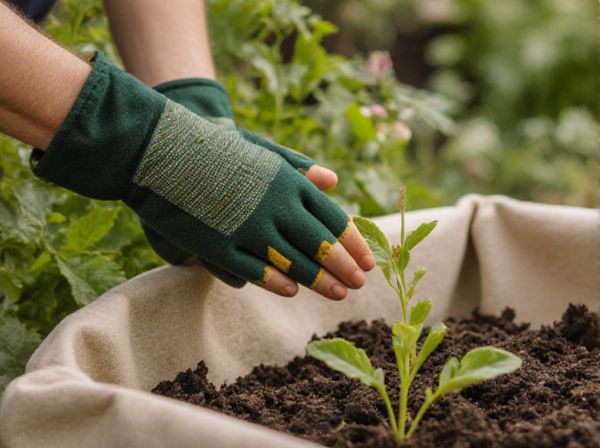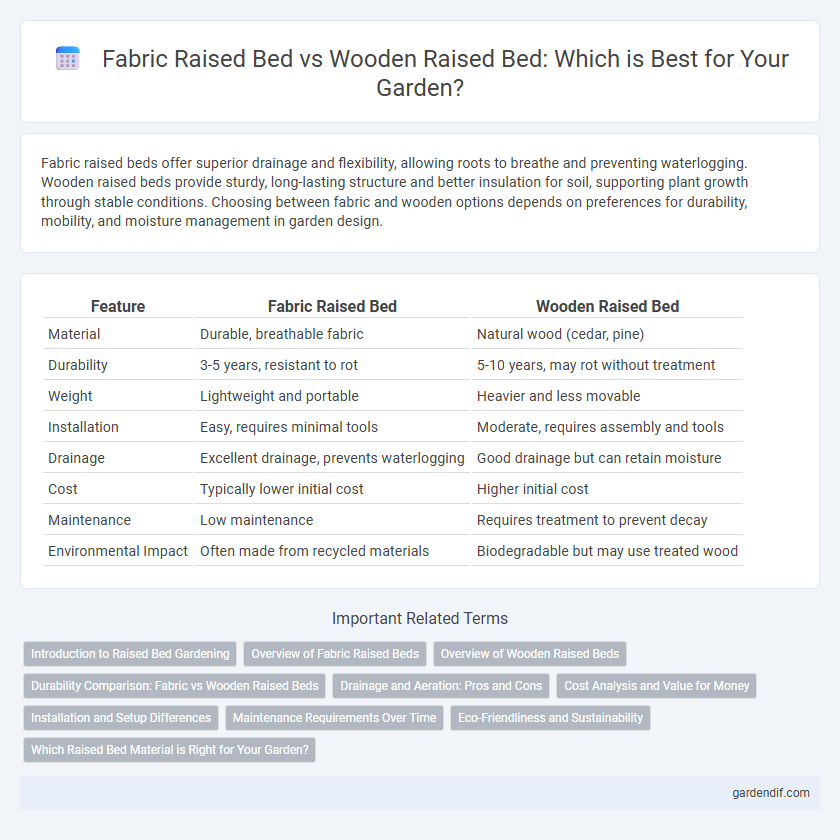
Fabric raised bed vs Wooden raised bed Illustration
Fabric raised beds offer superior drainage and flexibility, allowing roots to breathe and preventing waterlogging. Wooden raised beds provide sturdy, long-lasting structure and better insulation for soil, supporting plant growth through stable conditions. Choosing between fabric and wooden options depends on preferences for durability, mobility, and moisture management in garden design.
Table of Comparison
| Feature | Fabric Raised Bed | Wooden Raised Bed |
|---|---|---|
| Material | Durable, breathable fabric | Natural wood (cedar, pine) |
| Durability | 3-5 years, resistant to rot | 5-10 years, may rot without treatment |
| Weight | Lightweight and portable | Heavier and less movable |
| Installation | Easy, requires minimal tools | Moderate, requires assembly and tools |
| Drainage | Excellent drainage, prevents waterlogging | Good drainage but can retain moisture |
| Cost | Typically lower initial cost | Higher initial cost |
| Maintenance | Low maintenance | Requires treatment to prevent decay |
| Environmental Impact | Often made from recycled materials | Biodegradable but may use treated wood |
Introduction to Raised Bed Gardening
Fabric raised beds offer superior drainage and airflow compared to wooden raised beds, reducing the risk of root rot and promoting healthier plant growth. Wooden raised beds provide sturdy, long-lasting structures that retain soil moisture effectively but may require treatment to prevent rot and insect damage. Both options enhance soil quality and accessibility in raised bed gardening, making it easier to control weeds and optimize plant health.
Overview of Fabric Raised Beds
Fabric raised beds offer superior aeration and drainage compared to traditional wooden raised beds, promoting healthier root growth and preventing waterlogging. Made from durable, weather-resistant materials like polypropylene, these beds resist rot and pest damage, ensuring longevity without the need for frequent replacement. Their lightweight and flexible design allows for easy relocation and customization in various garden layouts.
Overview of Wooden Raised Beds
Wooden raised beds provide natural insulation and durability, enhancing soil health by maintaining consistent moisture levels and temperature. Commonly constructed from rot-resistant woods like cedar or redwood, they offer structural strength while blending seamlessly into garden aesthetics. Proper sealing and maintenance extend their lifespan, making them a sustainable choice for long-term vegetable and flower cultivation.
Durability Comparison: Fabric vs Wooden Raised Beds
Fabric raised beds offer moderate durability with resistance to rot and pests but typically last 3 to 5 years before replacement is needed. Wooden raised beds, especially those made from cedar or redwood, provide superior durability, often lasting 10 to 15 years due to natural decay resistance and sturdier construction. Proper treatment and maintenance can extend the lifespan of wooden beds, making them a more long-term investment compared to fabric options.
Drainage and Aeration: Pros and Cons
Fabric raised beds excel in drainage and aeration due to their porous material, allowing excess water to escape and roots to receive ample oxygen, reducing the risk of root rot. Wooden raised beds, while sturdy and durable, often require drilled holes or gaps to improve drainage, which can sometimes lead to water pooling and less effective aeration if not properly maintained. Fabric beds are ideal for plants needing well-drained soil, whereas wooden beds offer a more controlled environment but may need additional measures to enhance airflow and moisture regulation.
Cost Analysis and Value for Money
Fabric raised beds typically cost less upfront than wooden raised beds, making them an affordable option for budget-conscious gardeners. While wooden raised beds involve higher initial expenses due to materials like cedar or redwood, they offer greater durability and longevity, potentially reducing replacement costs over time. Evaluating long-term value, wooden beds deliver stronger support and enhanced resistance to weather, whereas fabric beds provide flexibility and easier setup at a lower price point.
Installation and Setup Differences
Fabric raised beds offer a lightweight and flexible installation process, requiring minimal tools and allowing quick assembly by securing stakes or folding edges. Wooden raised beds demand more effort during setup, involving cutting, drilling, and fastening boards together, often requiring power tools and precise measurements. Fabric beds provide easy relocation and drainage, whereas wooden beds deliver more structural stability but take longer to install.
Maintenance Requirements Over Time
Fabric raised beds require minimal maintenance, as their materials resist rot, pests, and weathering, but they may need occasional replacement every 3-5 years due to fabric wear. Wooden raised beds, particularly those made from untreated wood, demand regular sealing or staining to prevent decay and insect damage, with a typical lifespan of 5-10 years depending on wood quality and climate exposure. Both options benefit from routine cleaning and inspection to ensure structural integrity and soil health.
Eco-Friendliness and Sustainability
Fabric raised beds offer superior eco-friendliness due to their use of recycled, breathable materials that reduce soil waste and enhance water conservation, while wooden raised beds rely on natural, biodegradable timber but may involve chemical treatments that impact sustainability. The durability of fabric beds, often made from recycled plastics or organic fibers, extends their lifecycle with minimal environmental footprint compared to wood which can degrade or require replacement, contributing to deforestation concerns. Choosing fabric raised beds supports sustainability goals through resource efficiency and reduced ecological impact, making them a preferable option for eco-conscious gardeners.
Which Raised Bed Material is Right for Your Garden?
Fabric raised beds offer superior drainage and flexibility, making them ideal for gardeners seeking easy setup and mobility, while wooden raised beds provide durability and natural insulation, promoting healthy root growth in permanent garden installations. Cedar and redwood are popular wood choices due to their resistance to rot and pests, ensuring longevity without chemical treatments. Selecting the right material depends on your garden's size, climate, and maintenance preferences, with fabric beds excelling in compact, seasonal gardens and wooden beds preferred for established, long-term plots.
Fabric raised bed vs Wooden raised bed Infographic

 gardendif.com
gardendif.com